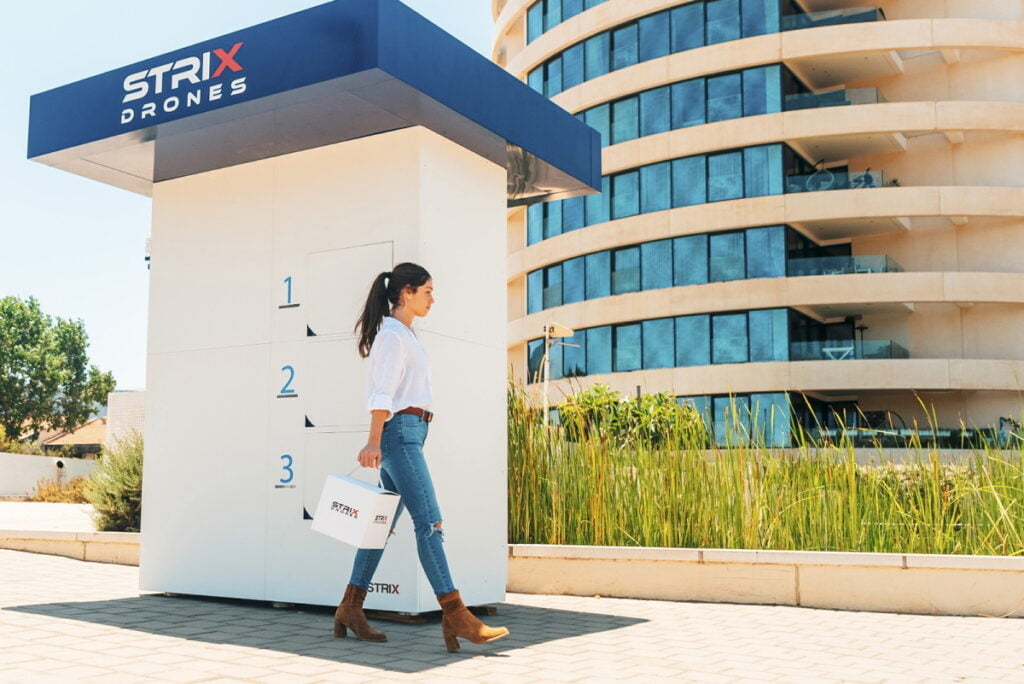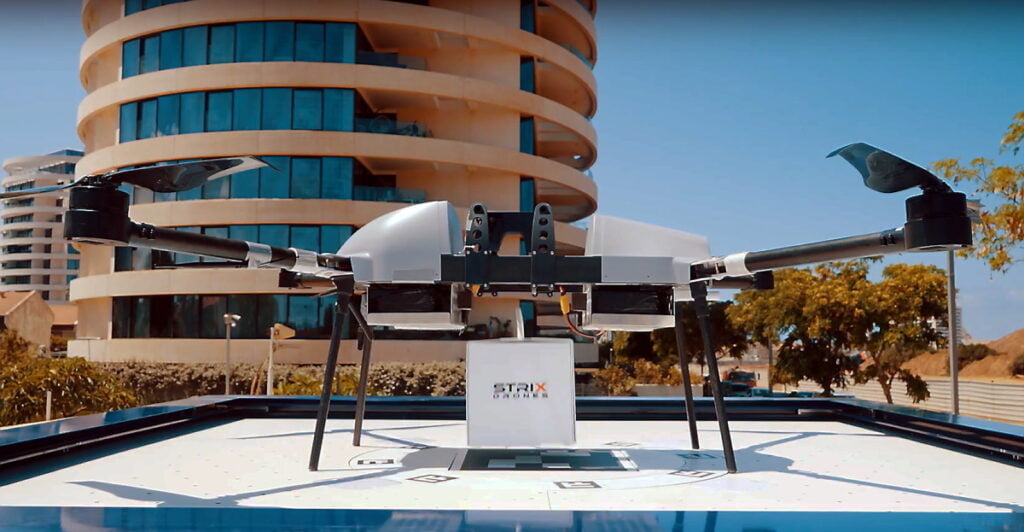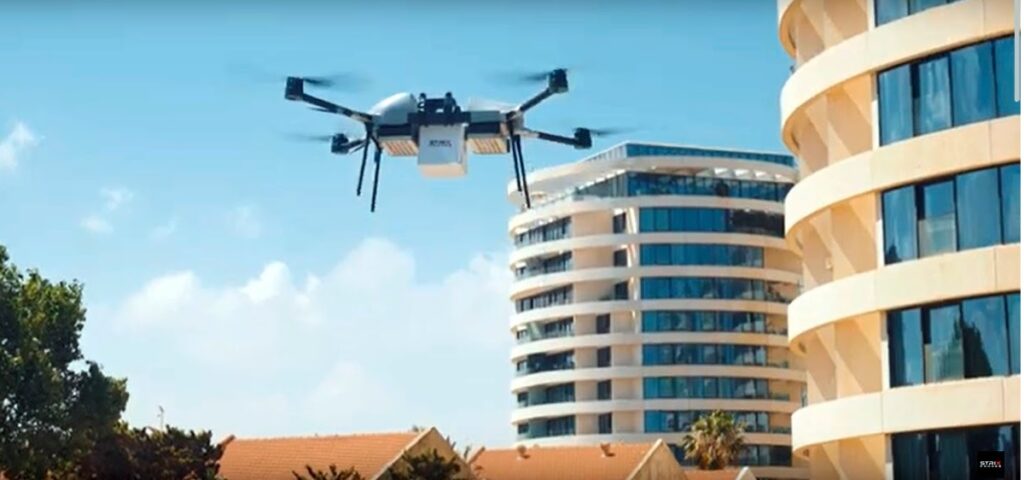Customers will receive text message to collect parcels from secure mailboxes
It’s the future of parcel delivery, and drone drop-off points like this (below) could be on street corners in Israel by next year.
Strix Drones, a startup based in Hod HaSharon, has developed a secure mailbox for online orders that arrive by air.
The drones will be programmed to deliver to the automated pick-up point, and the recipient will receive a message to say there’s a parcel waiting for them.

The drop-off points allow for the delivery of heavy and/or delicate goods, in urban areas with high-rise buildings or where difficult weather conditions and too-small mailboxes won’t deter parcel drop-off.
The company will start test-deliveries of groceries with a retailer in the coming months and plans to install its first docking stations in the city of Modi’in, in central Israel, next year.
The company has also established a manufacturing facility in Dayton, Ohio, USA, which will begin manufacturing docking stations to fulfill orders they already have, within the next two months.
Strix has signed contracts with factories in the area which will supply the docking station with components to begin assembling its products in an effort to make it possible to fully produce the product in the United States. Aharoni says the company will move production to the US by the end of the year.
The mailbox is a secure solution for all parcel deliveries by drone. “You don’t have to be there, that’s the most important thing,” Strix Drones CEO Niv Aharoni tells NoCamels.
“It’s going to be secure in the cell. The application gives you and only you the right to open it. When you are next to the location (within 10 meters) you can press a code, the cell will open, and you have 15 seconds to grab your package. After 15 seconds, the door will close automatically, for safety reasons.”
The docking stations can be deployed on sidewalks in urban areas, or on rooftops. “The docking station is made mainly to support all the needs of the drone,” Aharoni says.
“If you want a drone to deliver autonomously or automatically — meaning the pilot won’t be next to the drone — the only way to do that is to have a docking station,” he says. “If not, the pilot must be next to the drone. He needs to replace the battery. If there is rain, he needs to take the drone manually and put it in the car.

“He needs to fly the drone next to him because the drone must come back to him. He cannot fly from one point to another, because there is no person there. The only way to make a drone automatic or autonomous is to have a docking station in the field.”
Sign up for our free weekly newsletter
SubscribeThe drone doesn’t need anyone there to await its arrival, but the docking station will include what Aharoni refers to as a “safety camera,” which will film the drone’s whereabouts for a pilot in another location, in order to authorize its landing.
The Strix 1600 docking station, houses a landing pad of 1.6 meters-by-1.6 meters (5.25-feet-by-5.25 feet), and the Strix 2100, has one that is 2.1-meter-by-2.1-meter (about 7-by-7 feet). According to Aharoni, the drone brings the package to the agnostic docking station, where an elevator takes the parcel and places it in a cubicle. The recipient receives a message via text and email with the package’s location and cell number, and where it is being held.
“You don’t have to be there, that’s the most important thing,” Aharoni adds, “It’s going to be secure in the cell. The application gives you and only you the right to open it. When you are next to the location (within 10 meters) you can press a code, the cell will open, and you have 15 seconds to grab your package. After 15 seconds, the door will close automatically, for safety reasons.”

The docking stations can be deployed on sidewalks in urban areas, or on rooftops. “The docking station is made mainly to support all the needs of the drone,” he says.
Strix was founded just three years ago and has already launched a successful pilot in Israel. Last month, it took part in the Israel Innovation Authority’s ongoing National Drone Initiative with the Israeli Ministry of Transportation, the Civil Aviation Authority of Israel, and Ayalon Highways Ltd. The company plans to put docking stations in areas in the city of Modiin in central Israel and also test delivery of groceries with a local retailer in the coming months.
Aharoni tells NoCamels the company already has about 20 customers in the US including billion-dollar firms, like one in Arizona involved in deliveries of blood and COVID-19 tests, among other medical items, to hospitals, and a top Tier 1 retail corporation.
“We are talking to companies in the medical field and we are talking to retail companies, these are our two main customers and right now we have one of each,” Aharoni says, adding that the company is not looking into delivering food at this time because it doesn’t work with the system they are currently testing right now.

Strix Drones’ system is agnostic, meaning it can communicate with any type of drone in the world and can deliver packages from different companies. Its docking station also includes a charger that will be able to charge any type of drone.
“On our unit you can charge any kind of drone and this is something that we invented because on one charger we can charge all types of drones, whether it’s a drone from Amazon, a drone from Walmart, or a drone from Facebook, whatever it is, can land on our unit and be charged. You cannot find this anywhere else.”
The company also provides information about the status of the battery to the customer. Communication is important to us, Aharoni explains. “We know how to connect to the drone. We know how to download information from the drone. We know how to upload. And it is fully automatic,” he says.
“We want to close the gap between the drone and the customer and we are in the middle. We want to solve the problem of communication between the two — even without words.”
Related posts

Editors’ & Readers’ Choice: 10 Favorite NoCamels Articles

Forward Facing: What Does The Future Hold For Israeli High-Tech?

Impact Innovation: Israeli Startups That Could Shape Our Future




Facebook comments